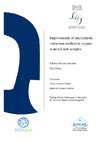Please use this identifier to cite or link to this item:
https://accedacris.ulpgc.es/jspui/handle/10553/74539
| DC Field | Value | Language |
|---|---|---|
| dc.contributor.advisor | Gómez Cabrera, María Milagrosa | - |
| dc.contributor.advisor | Herrera Ulibarri, Alicia | - |
| dc.contributor.author | Garrido Amador, Paloma | - |
| dc.date.accessioned | 2020-09-22T11:09:27Z | - |
| dc.date.available | 2020-09-22T11:09:27Z | - |
| dc.date.issued | 2016 | en_US |
| dc.identifier.uri | https://accedacris.ulpgc.es/handle/10553/74539 | - |
| dc.description.abstract | Because of their small size, microplastics are available for many marine organisms. Their consumption can be hazardous and have chemical, physical, and biological effects. Nowadays, the scientific community is focused on determining the microplastics abundance and distribution, to gain a better understanding of the magnitude of this global problem. Prior to that, it is essential to harmonize sampling, extraction, and quantification methodologies in order to get reliable and reproducible data of microplastic contamination. Several methodologies have been described for the digestion of animal tissue and zooplankton within microplastic samples, but methodologies for digesting algal and vegetal material are not well known, although this material is abundant in sediment samples (e.g. beach sediment samples). The aim of this study was to determine which digestion protocol was more efficacious at digesting vegetal and algal material, defining then a standard digestion procedure for the extraction of microplastics from algae and vegetal material rich samples. Not only digestion efficacy, but the potential support of density separation steps, and the safety of the plastic particles during the digestion procedure, were examined. Among five described digestion methodologies, using HCl, NaOH, KOH and H2O2, the protocol based on Masura et al (2015) methodology, was selected as the most promising procedure for the extraction of microplastics from algae and vegetal rich samples. | en_US |
| dc.language | eng | en_US |
| dc.relation | Microtrophic | en_US |
| dc.subject | 241705 Biología marina | en_US |
| dc.subject.other | Microplastic | en_US |
| dc.subject.other | Algae | en_US |
| dc.subject.other | Vegetal debris | en_US |
| dc.subject.other | Extraction | en_US |
| dc.subject.other | Digestion | en_US |
| dc.subject.other | Efficacy | en_US |
| dc.title | Improvement of microplastic extraction method in organic material rich samples | en_US |
| dc.type | info:eu-repo/semantics/masterThesis | en_US |
| dc.type | MasterThesis | en_US |
| dc.contributor.departamento | Departamento de Biología | en_US |
| dc.contributor.facultad | Facultad de Ciencias del Mar | en_US |
| dc.investigacion | Ciencias | en_US |
| dc.type2 | Trabajo final de máster | en_US |
| dc.description.notas | Máster en Oceanografía ; 2015-2016 | en_US |
| dc.utils.revision | Sí | en_US |
| dc.identifier.matricula | TFT-37635 | es |
| dc.identifier.ulpgc | Sí | en_US |
| dc.contributor.buulpgc | BU-BAS | en_US |
| dc.contributor.titulacion | Máster Universitario en Oceanografía por la Universidad de Cádiz, la Universidad de Las Palmas de Gran Canaria y la Universidad de Vigo | es |
| item.grantfulltext | open | - |
| item.fulltext | Con texto completo | - |
| crisitem.advisor.dept | GIR ECOAQUA: Ecofisiología de Organismos Marinos | - |
| crisitem.advisor.dept | IU de Investigación en Acuicultura Sostenible y Ec | - |
| crisitem.advisor.dept | Departamento de Biología | - |
| crisitem.advisor.dept | GIR ECOAQUA: Ecofisiología de Organismos Marinos | - |
| crisitem.advisor.dept | IU de Investigación en Acuicultura Sostenible y Ec | - |
| crisitem.advisor.dept | Departamento de Biología | - |
| Appears in Collections: | Trabajo final de máster | |
Page view(s)
205
checked on Nov 1, 2024
Download(s)
639
checked on Nov 1, 2024
Google ScholarTM
Check
Share
Export metadata
Items in accedaCRIS are protected by copyright, with all rights reserved, unless otherwise indicated.
